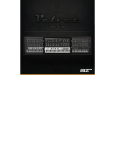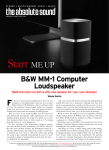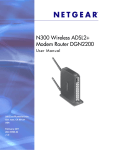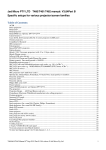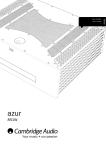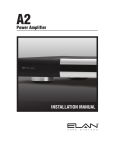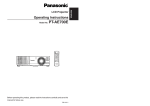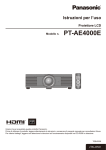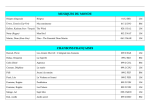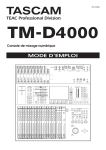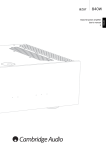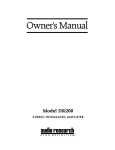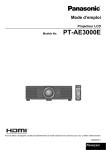Download AudioEnz - Panasonic PT
Transcript
March 2010 Web page printouts from the latest issue of AudioEnz http://www.audioenz.co.nz/acrobat/issues/2010/2010-03.pdf www.audioenz.co.nz AudioEnz editor: Michael Jones ph 027-44 999 75 AudioEnz - Panasonic PT-AE4000E http://www.audioenz.co.nz/2010/panasonic_ae4000.shtml Panasonic PT-AE4000E By Nigel Beale March 2010 Panasonic PT-A4000E. $4299 The most notable aspect of the AE4000E in New Zealand is Panasonic’s price point. Despite the very competitive pricing which more or less aligns New Zealand with overseas markets, the AE4000E includes a number of key upgrades from earlier models that make this projector more valuable than its predecessors. So it’s a double win for the local consumer. I was quite excited when I first heard about some of the features in the Panasonic AE4000E and I was keen to get my hands on one to check it out. The same... but different Visually, the AE4000 is essentially unchanged from previous 1080 models, and some argue that the look will never win many wife approval awards. If you are into function over form then you will ignore the appearance. I don’t mind it myself, the daughters first comment was, “what a beast!” Can’t argue with that. The dimensions of the AE4000 (130x460x300mm HxWxD) fits a shelf location quite well, but allow for 50-100mm at the rear for connections and power. For ceiling mounting you will need a bracket capable of supporting 7kg of weight. Of course make sure the support bracket actually grips something solid. The AE4000E has several advances from the AE3000E that work together to deliver a substantial increase in overall performance. By a quick glance of the spec sheet these are not overly apparent. The contrast ratio going from 60,000:1 to 100,000:1 is the obvious step, but a less obvious one is the lumen rating, which on paper is the same as the previous model. Panasonic has developed a red enriched lamp for this model, so although the lumen value is the same the output at the screen is substantially higher. The reason for this is that this new design overcomes the problem with the traditional projector lamp AudioEnz - Panasonic PT-AE4000E http://www.audioenz.co.nz/2010/panasonic_ae4000.shtml that is deficient in red. With the traditional lamp when balancing the red, green and blue to the correct levels (ITU-R BT.709), typically lowers the lumen output limited by the red. The vast majority of traditional projector lumen ratings are based upon a less than accurate image to get the higher outputs, the dynamic modes. Although even here the highest rating is still based upon dynamic mode that does in fact clip, the overall red boost comes through into all modes. When using the accurate modes the increase from the earlier models is measurable and visual, the red enriched lamp does indeed result in higher lumens output than previous models whilst maintaining accurate image balance. After the LCD panels there is a new pure contrast plate to filter light leakage. Light leakage is the basic limit of the black level obtainable by an LCD based projector and so with the leakage blocked the black level is lowered. Basically less greyness to the low light level image, the traditional weakness of the LCD based projector. The result of the combined filtering and the red enriched lamp, and not forgetting the fifth generation intelligent iris, all combine to increase the dynamic range commonly known as contrast ratio, hence the spec sheet increase from 60000:1 to 100000:1. Additionally there is a pure colour filter, which assists the colour balancing act to adhere to the standards. The mode Colour1 is the closest to ITU-R BT.709 – the official HD reference standard for video imagery. Colour2 is aimed at the DCI standard. There are even more advanced features involving colour management, white balance and gamma tracking, which I’ll go into in the really geeky section of this review. There is various image processing options that have been revised and added, Panasonic's Smooth screen technology continues as in previous models and functions very well to remove the LCD structure, no change here as this is already well developed. Further processing is done with the ‘Detail Clarity Processor 3’ with seven steps of adjustment that acts like an advanced sharpness control. This processor analysers the image to try and reproduce information damaged by compression or other losses. Then there is the updated frame interpolation technology that is known as ‘Frame Creation 2, with motion blur reduction’, with options, off, mode1, mode2 and mode3. Displaying 50hz/60hz material there is an additional frame added so you will see 100hz/120hz and for 24hz material an additional 3 frames are added so you see 96hz. Each mode just makes the effect more or less pronounced. A note with these processors is they add time delay to the image processing so you need to add delay to audio when using these. AudioEnz - Panasonic PT-AE4000E http://www.audioenz.co.nz/2010/panasonic_ae4000.shtml The lens memory function has been updated as well with auto detection so you don’t need to dive into menus to switch between your stored zooms. This has six memories for zoom and focus. Devised as a pseudo anamorphic setup, although not true anamorphic it does allow for the use of a wide angle screen for the 2.35:1–2.40:1 movies then zooming to a different position for 1.78:1 There is a true stretching option to use all the LCD pixels then reshape the image with an external anamorphic lens. So the AE4000E is capable of true anamorphic constant height setups as well. The lens has 2x optical zoom and lens shift allows for +/-40% horizontal and +/-100% vertical movement. It of course has keystone correction, but I advise use of this only if there is no other option as it destroys resolution. So how does all this sum up? Really quite superb. The exact words from my wife were (before viewing), “so how is this projector better than what we have now?” Peering at the my old AE900E looking nervous perched up on the roof, “Everywhere dear”. Thirty minutes later and the wife mutters, “This is just unreasonably good” One of the things that really had me startled is how good upscaled standard definition is. First disk on was Half-light, which actually is a really good reference for natural colour and has an excellent range of high contrast scenes. Despite the only copy I have of it being standard definition on DVD, upscaled from my BD35 at 1080p50 it blew away my wife with detail and colour (colour1). The detail clarity feature is targeted more at this sort of material, you actually shouldn’t need much enhancement on true HD material. Although the BD35 plays its part in this the image upscaling was never this good on my AE900E despite keeping it well tuned. The AE4000E just takes it to another level. Next up was Blackhawk Down on Blueray, this was even better even though it is a naturally grainy movie. I played with the frame creation feature, which works by creating more frames of information between the original frames, the effect works surreally on your head. If you haven’t seen frame creation working, this is worth a look. Although some find the effect less film like as the extra frames creates a digital look. Then again the film look is just our heads used to lower flicker rates. Panasonic projectors, from the early days of the AE300E until now do what I like to see with hardware, where the manufacture incrementally updates each year. Every few models though we have seen a big technology jump from a previous years model. The AE700E is an example, then the AX100, the AE became the 1080 model range with the AE1000E. Now we have the AE4000E and I believe we have another of the performance jump models. You can argue the pros and cons of any of the current crop of 1080 projectors and still have your personal favourites. But in all reality, for hit power for buck Panasonic and the New Zealand consumer are on a winner here, with the AE4000E at a rrp of $4299 there will be a number of current projector owners let alone any first timers to the projection world thinking buy now time. So if you are thinking about an upgrade or new purchase this one is worthwhile considering. Part two – the geeky stuff Nigel Beale of Masterpiece Calibration Ltd is an ISF-qualified calibrator working out of Christchurch. Phone him on 027 204 3090. AudioEnz - Panasonic AE4000 the geeky stuff http://www.audioenz.co.nz/2010/panasonic_ae4000-geeky.shtml Panasonic AE4000 - the geeky stuff By Nigel Beale March 2010 Panasonic PT-A4000E. $4299 Continued from the Panasonic AE-4000 review The waveform monitor returns again, although most people don’t understand its purpose. It is not uncommon to find the source equipment varies in output levels, the idea here is to match the source output levels so that you do not clip the top end ‘contrast’ or cut off the bottom end ‘brightness’ of the source. Running the auto align with a stepped greyscale from your player matches the projector to the player. Now the section I was so eager to get my hands on. Even though the Colour1 mode is good out of the box it can be fine tuned to be even tighter tolerances or any of the other modes can be dialled in as well. Deep in the AE4000E menus are some serious calibration tools for the advanced enthusiast and professional calibrator to fine tune the image, though I should point out with the advanced calibration tools doing anything by eye will probably lead to creating a mess of the image. Firstly, the old colour management tool, which has been part of the AE projectors for a long time, which no one ever used because it did absolutely nothing useful except to change one colour out of thousands to another colour, finally has been updated. The old mode exists, however switch it to the six colour mode and it is now a functioning colour management tool to set the primaries and secondarys closer to HD standard ITU-R BT.709 or any other gamut within the adjustment range. Although the tool is disabled in Colour1 or Colour2 modes since these are predefined and fairly accurate out of the box, you can however use it in any of the other modes that uses the default full gamut range producible by the projector. For white balance there is the standard RGB cuts and gains, but for the gamma section there is a new adjustment tool with two main options, the traditional low, mid and high gamma control and an advanced option. Enabled allows for a nine-point adjustment of Y, R, G and B gamma tracking. This is a really powerful tool for the professional calibrator, even though it does add quite of bit of time to do a calibration process the resulting gamma white balance tracking can be superb. The following charts are a calibration of Cinema 1 mode, it doesn’t get any better than this, enjoy. To the left is before calibration, to the right is after calibration. AudioEnz - Panasonic AE4000 the geeky stuff http://www.audioenz.co.nz/2010/panasonic_ae4000-geeky.shtml AudioEnz - Panasonic AE4000 the geeky stuff http://www.audioenz.co.nz/2010/panasonic_ae4000-geeky.shtml Nigel Beale of Masterpiece Calibration Ltd is an ISF-qualified calibrator working out of Christchurch. Phone him on 027 204 3090. AudioEnz - Firestone Audio Fireye I and II http://audioenz.co.nz/2010/firestone_fireye.shtml Firestone Audio Fireye I and II By Shane Hanify March 2010 Firestone Audio Fireye I headphone amplifier ($199) and Fireye II USB DAC/headphone amplifier ($279). When you first pull these little silver boxes out of their quality packaging, immediate comparisons are drawn. Both come with a mini USB lead, and the same faux felt bag to protect the outside world from these solidly built aluminium cased amps, a basic user manual listing features, specifications and operating instructions. The I also includes a short cable to connect the amp to whichever (portable) source you use. The Fireye I is a battery powered headphone amplifier designed to run from a source – usually an mp3 player. It has only input and output 3.5mm sockets, a status LED, and a mini USB for charging the internal battery. There is no volume control, this being dictated by the source you use. The Fireye II is a headphone amplifier powered by USB from your computer or mains powered (the power pack is not supplied with the unit). Fireye recommend mains powering with hard to drive loads. The II has a volume control – which balances to the right at extremely low volumes and doesn't appear to do much after about 60%. The headphone jack also doubles as an optical digital out, which you can pass into a better DAC or suitable amp. Setup I had my AKG k171s on hand, but was also was lucky enough to be lent a pair of Grado SR80i's and an aftermarket USB cable for the Fireye II which was used for the duration of this review. First impressions AudioEnz - Firestone Audio Fireye I and II http://audioenz.co.nz/2010/firestone_fireye.shtml Out of the box, and still fresh, both amps impressed. As with all entry-level gear, they prefer uncluttered simple acoustic music. Heavy or busy works unsettle them slightly, but not nearly as much as you'd expect for the price. Female vocalists in particular really stood out for me, with an air and grace that had me listening for hours on end. One thing you have to be mindful of though are poor recordings. Your mp3 player or computer may gloss over those but these two will not. Feed them rubbish and they will reward you with more than a harsh stare. Battery life on the Fireye I was good, regularly rewarding me with over 20 hours between charges, although when it loses power it simply stops without warning. The little brother The Fireye I sounds quite passable off the back of an mp3 player and It easily has enough grunt to run even my more demanding phones to ear splitting levels with contemporary music. This has a warm presentation but is a touch light in the midbass. For some genres, such as light jazz or vocal this suits, but when it comes to hard driving rock or big classical works the II wins out. Moving on up As I listened to the Fireye II, I started to warm to it. Music had more body, and there was a greater sense of space around instruments allowing the performances to breathe. As I relaxed into the music and stopped worrying about the sound it started to sparkle and shine. When used instead of the headphone jack in the PC, the output was whisper quiet with no tiresome pops and clicks. Final conclusions Despite a few minor flaws and niggles, such as the woeful instructions and a volume control on the II that could be better implemented, I'd have no hesitation in recommending either of these. They're solidly built, sound great, are brilliant value for money and should last for years. AudioEnz - Tri 35SE Integrated Amplifier and CD4SE CD Player http://audioenz.co.nz/2010/tri_35se-CD4se.shtml Tri 35SE Integrated Amplifier and CD4SE CD Player By Brent Burmester March 2010 Tri 35SE Integrated Amplifier ($3300) and CD4SE CD Player ($3300) There are no thermionic valves amidst the thousands of miles of circuitry in the Large Hadron Collider. I didn’t read that anywhere, and I certainly didn’t bother to ask anyone who’d know: it just must be true. Who, in their right minds, would build anything remotely important relying on a fragile, short-lived, temperamental, and expensive light bulb, if they really didn’t have to? Am I claiming, then, that sound recording and reproduction, where valves continue to find a use, isn’t important? That would be an unlikely move for a hi-fi reviewer. Maybe my contention is that a great many audio professionals are insane? While quite possible true, that is incidental. My point, and I do have one, is that we still use valves in high fidelity sound reproduction, because we have to. Really. Stranger than fiction Now, if you’re sitting across from a megawatt of semiconductor-saturated amplification, you may have reason to think me wrong. Some of us measure quality in undistorted decibels at 25Hz, and valves are certainly at a disadvantage there. Similarly, you’ll find my claim contentious if your budget for new components is less than $1k, you don’t have room for 3m wide horn-loaded speakers, you could never trouble yourself to switch your system off once it was plugged in, or maybe you occasionally let your separates bounce down a flight of stairs, just to air them out. Anyway, I see the point you’re making. To see, or rather, hear, my point, I recommend you find yourself an audio set-up featuring products from the Triode Corporation of Japan, or Tri to its friends. If the Japanese, the People of the Transistor, still have time for valves you know they must be special (the valves). While Tri’s speciality is amplification, it also makes a source component in the form of the CD4SE CD player. I had the good fortune to enjoy the pairing of this player with the firm’s 45 watt 35SE integrated amplifier. AudioEnz - Tri 35SE Integrated Amplifier and CD4SE CD Player http://audioenz.co.nz/2010/tri_35se-CD4se.shtml Mysterious ways You could make a case for owning these beauties on the grounds of looks alone. Valve amps, in their glowing finery, deserve to be on display. The matching aesthetics of CD player and amp is very pleasing, provided you like red, and the quality is not merely skin deep in the case of the Tri hardware. Both CD player and amplifier are solidly made and feature high quality connecting hardware on their back panels and carefully selected and laid-out gubbins within. As is often the case with valve amplifiers, the 34SE offers a 6 or 8 ohm speaker load option. Initially, I played safe with the 8 ohm option, in keeping with the nominal impedance of my Magnats. Listening with my reference sources, rather than the Tri player, I was immediately struck by the full-blooded sound that greeted me. I was reminded that 45 watts per channel is a lot of valve power. The tangibility of every musical performance was a marked improvement on similarly powered, even similarly priced, transistor amps. I was not disappointed by obvious ‘valve-ish’ weaknesses bemoaned in certain hifi circles. The frequency response was not limited to the mid-range, with a dulled top end and a detached and flaccid bassline, nor was it given an extra coat of varnish, or three. My only reservation was with respect to the bass. It wasn’t weak or tuneless, but there was a discernible rounding off on the leading edges of thumbed bass guitar or synthesised percussion. When I experimented with the 6 ohm outputs I found a improvement in this regard, and a more precise control of volume as well, although it’s true that transistor amps in this price range would strike harder. As a torture test – valve-lovers skip to the next paragraph! – I let loose the Chemical Brothers, Orbital, and the Prodigy, and still found the grins arriving at the right moments. That was reassuring, but these artists don’t show the 35SE to best advantage. Mary Black, Tori Amos, John Renbourn, Jacques Loussier, anything recorded on ECM, now you’re talking. The 34SE can hammer if called upon, but it’s real intention is to draw the listener into the melodic charms of the music, rather than the rhythmic. Born to be alive Introducing the Tri CD4SE player to its amplifying team-mate shifted the game to a new venue. This player features 24/192 upsampling and a valve in its output buffer for improved impedance matching. While an excellent unit in isolation, seldom have I head a source and amp combination from one manufacturer work so harmoniously together. They were very hard to fault, giving highly expressive accounts of everything they were fed. Working together, the two lacquered beauties imparted a captivating vitality to live recordings, from Jethro Tull to Cirque de Soleil. I suppose my only complaint would be that my poorly engineered CDs didn’t get a dose of that Vaseline-on-the-lens effect that valves are supposed to impart. Oh, that’s not a fault at all. However they might be compromised, we continue to rely on valves in hi-fi because, at their best, they are just a little more alive than the alternative. Tri’s 35SE and CD4SE are about back-to-basics two-channel audio, so if your system has to have multi-room, multi-channel, multi-media compatibility, AudioEnz - Tri 35SE Integrated Amplifier and CD4SE CD Player http://audioenz.co.nz/2010/tri_35se-CD4se.shtml never mind. This combination is worthy of consideration by everyone wearying of the anaemic or fussy performance of their solid-state hardware, and those who want the indispensable discs in their collection to be as arresting as when they were first heard. AudioEnz - Tannoy Revolution DC4T http://www.audioenz.co.nz/2010/tannoy_dc4t.shtml Tannoy Revolution DC4T By Matthew Masters March 2010 Tannoy Revolution DC4T. $1399 “Calm down”, the doctor told me, “relax a bit” he said, then “do some exercise”. It was intended as advice to help me lower my blood pressure, but it really wasn’t having the desired effect. Relax and exercise at the same time. Now that was just confusing. Then came the king hit... giving up most everything that actually helps me relax. In my case that included espresso coffee. Now, as any fool knows, a fine espresso is one of life’s essential sensory experiences, a sublime nectar to be enjoyed in tiny sips, and preferably only after observing the correct ritual of pressures. Grind the beans, tamp the fine powder just enough, then force hot water through the grounds at precisely the right temperature. Get the proportions right and you’re rewarded with a thick, richly aromatic and highly concentrated confection guaranteed to quicken your pulse and sharpen your mind. The colour of a well-drawn espresso is subtle and as variable as the preparation’s flavour, from an inky deep brown to richly pale cream at the top. But it’s the dark colour that dominates. Okay, so perhaps I was obsessing a little about what I was having to sacrifice at the altar of hypertension, but espresso was the first thing that sprang to mind when I saw Tannoy’s new Revolution series DC4T speakers. Small, dark and concentrated. Milk or cream? Never Actually, the connection is no accident. Tannoy actually call the deep brown, real wood veneer “dark espresso”. I was half expecting to see “flat white” for the blonde version. Alas that has the rather more prosaic name of light oak. Tannoy’s Revolution range of speakers sits one step up from their entry-level Mercury series but has AudioEnz - Tannoy Revolution DC4T http://www.audioenz.co.nz/2010/tannoy_dc4t.shtml more in common with the far plusher Revolution Signature series, in particular a pair of classy drivers that includes a very tasty dual-concentric with titanium dome for high frequency duties. By any measure, the DC4T is compact for a floorstanding loudspeaker. Very compact in fact, standing just 850mm tall by 152mm wide at the front, and 162mm deep. The trapezoidal section of the cabinet helps to reduce internal standing waves but does contribute to a positively espresso-sized 3.43 litre internal volume – less than a few stand mount speakers I can think of. The small footprint has one immediately noticeable drawback, these Tannoys are remarkably easy to knock over. However, at 8.5kg each they’re surprisingly dense, so there is at least some inertia to overcome. Warming the demitasse With their tiny size and equally diminutive drivers (don’t be deceived by the rather smart alloy surrounds, those drivers are a mere 100mm diameter each), the Tannoys look like a perfect match for the small, carpeted rooms in modern townhouses or apartments. So naturally, I set them to work in a cavernous, high-ceilinged living-room with minimal furnishing and hard floors. Yes, they did look a little like a single-shot espresso swilling round in the bottom of a super-size takeaway cup. But that said, my first taste of the DC4Ts proved immensely satisfying. First the aroma Starting with the Flower Duet, from Léo Delibes’ 1883 opera, Lakmé (Michel Plasson, EMI 56569). This competent, if unadventurous interpretation of Delibes best-known piece was rendered beautifully by the little Tannoys, with Natalie Dessay and Delphine Haiden’s vocals hovering sensuously in space. And what a space it was, with a sense of vast expanse on either side of the speakers, filled by the gentle counter-beat of the orchestra. There’s little muscle to the presentation, after all there’s only so much air a couple of 100mm drivers can move, but the overall impression was one of actually feeling the shape the performance (if not quite its scale), and getting lost on that imaginary Indian riverbank. Then the rush Sometimes, of course, you’re looking for a bit of a pick-me-up, rather than involvement. A bit more of that caffeine jolt, and less of the subtle stuff. And here the Tannoys find their limitations just a bit sooner. Listening to Jamiroquai’s Cosmic Girl you are immediately reminded of the limitations of modern music production. The mid-bass in this track is very prominent (to the point of dulling the mid-range), and the lower bass rather indistinct. And while the rhythmic structure of the song is preserved accurately, the overall effect is simply muddy and irritating. I’m not entirely convinced that this is actually the fault of the Tannoys though. Travelling Without Moving is a poorly produced album by any standard, the Tannoys are simply telling that story and their (comparatively small) weaknesses make it quite noticeable. Get lost in the whole experience With that, slightly bitter experience fresh in my mind, I went for another vast soundscape in which to get lost. Although a simple arrangement (little more than a wandering 10-minute guitar solo) Funkadelic’s Maggot Brain is a psychedelic guitar epic that, with the right system, can detach the listener from any sense of reality. And the Tannoys certainly did the job. From the delicate and achingly sad beginning, each scale progression is delivered with more and more intensity, but always without the confused blur that can emerge from Eddie Hazel’s, effect-rich playing. Fuzz-box, wah pedal and reverb are clearly articulated additions, rahter than the dominant sound. Musicality is preserved and Eddie takes you on his, frankly rather disturbing, journey. AudioEnz - Tannoy Revolution DC4T http://www.audioenz.co.nz/2010/tannoy_dc4t.shtml Finally, I shall make just a brief mention of Nouvelle Vague. In particular the gorgeous array of French female vocalists that the Tannoys just seem to love. Their deft handling of mid and upper ranges, combined with truly excellent imaging give an intimate presence to practically everything on the French collective’s first two albums. An experience for purists What it all boils down to, I guess, is taste. If you’re the sort of person that likes a decaf-soy-mocca with extra sugar, served in a bucket-sized cup with a little plastic hat on the top, the chances are you probably won’t like the Tannoy DC4Ts very much. But if you prefer less of something that’s far, far purer; an elegantly-crafted sensory treat, then you may well like what they do. The Tannoy DC4Ts certainly have their limitations in bass weight and dynamic capability, but that doesn’t seem to matter very much when you’re enjoying the music. At $1400 I’d buy them in a heartbeat. If I weren’t under instructions to keep that under control. AudioEnz - Simaudio MOON i3.3 http://audioenz.co.nz/2010/sim_moon-i3.shtml Simaudio MOON i3.3 By Michael Wong March 2010 Simaudio MOON i3.3 integrated amplifier. $6000-$7600 New arrival to the New Zealand audio scene, Simaudio, is a well established (since 1980) Canadian company whose reputation was built on their stylish, high performance amplifiers. Later their repertoire expanded to include digital playback and home theatre equipment. From the outside the Moon i3.3 looks like any other high-end integrated amplifier. It’s well built with a solid metal fascia, a large tactile volume control and a very legible, switchable red LED display. Hefty side panels doubling as (finger friendly) heat sinks and the rattle-free damped metal lid show careful attention to detail. Look through the top vents and you can see the large 400VA toroidal power transformer. Another nice touch is the inclusion of a front panel analogue input mini-jack (labelled MP, Media Player) for connecting your portable devices. Around the back we find various high quality input connectors, some chunky multi-way speaker cable binding posts, the main power switch and a few surprises. A generic but functional plastic RC5 coded remote control completes the presentation. Under the conservative Clark Kent exterior lurks a real Superman of an amp. Better make that Wolverine, a Canadian comic book character more appropriate for this analogy. The large power supply allows the amp to output 100wpc into 8 ohms or 200wpc into 4 ohms, with the first five watts in Class A. Perhaps even more important is the healthy 22A of output current. Enough to satisfy current hungry speakers like my Magnepans. Where the Moon trumps most of the competition is in its modular design that allows the basic amplifier to be AudioEnz - Simaudio MOON i3.3 http://audioenz.co.nz/2010/sim_moon-i3.shtml enhanced with some very useful options. The first is the “D” DAC board ($800) featuring a 196kHz/24-bit Burr-Brown converter with four digital inputs; Toslink optical, 2x RCA S/PDIFs and USB. Second is the “P” MM/MC phono stage ($600) with adjustments for resistance loading, capacitance loading and gain. Finally there is an “X” balanced input option ($300) that provides a single set of balanced inputs. When fully spec’d in one hit the price comes down to $7600, a saving of $200 over the individual prices. The review sample was supplied in fully loaded DPX spec. All but the balanced input option was sampled as I don’t currently have any sources with a balanced output. Vinyl replay was via a Well Tempered Turntable with Shelter 501/MkII cartridge, digital replay primarily by a Marantz CD-23 (supplemented by Pioneer and Panasonic), auxiliary sources from Denon, Nakamichi and Sony rounded out the music providers. Loudspeakers from Magnepan, AR and Energy. Cabling by XLO, MIT, Stax and Audioquest. Everything just sounded right Listening to music through the Moon was a most enjoyable experience. Everything just sounded right. Music was presented in a colourful and engaging manner without being over-analysed or obscured. Tonally the amp was warm (natural musical warmth, not the faux tube warmth many solid state designers are so fond of), smooth and forgiving. Highs were clean and reasonably extended, with good clarity and detail. Mids were smooth and lucid. Bass was not overly extended or particularly potent but was tuneful and filled out the bottom end nicely. Overall the sound was well balanced, without any undue emphasis on any part of the audible spectrum. Soundstaging wasn’t quite as explicit as my Krell reference amplifier but the Moon more than adequately conveyed the sense of space on a recording and reproduced images with good dimensionality and realistic size. Transparency was also of a high standard, with just a touch of darkness and none of the spotlighting effect of some amplifiers. Dynamics were slightly softened but the Moon did a good job portraying the power and excitement in music with an excellent sense of control, coupled to plenty of impact and punch. The phono stage stood out as an excellent performer, with just some roll-off at the frequency extremes, a slight flattening of perspective and softening of dynamics. Overall bettering the cheaper stand-alone phono preamps and getting close to the benchmark sub-$1000 phono preamps. The optional DAC also put on a fine performance, doing a fine job with my digital disc players. The exception was with my Marantz CD-23 as a transport. The Moon not quite matching the Marantz’s onboard DAC, showing a very slight loss of immediacy, reduced dimensionality and tunefulness. A real winner Simply put, this is one of the most enjoyable amplifiers I have heard for under $10,000. The design is so cannily balanced in its abilities that it’s hard to level any real criticism at it. There are just a few minor niggles that won’t bother anyone except persnickety reviewers. The sheer musical satisfaction, coupled to the fine versatility and excellent build quality makes the Moon i3.3 a real winner and great value for money. Power, soul and emotion personified. AudioEnz - Rega’s Phil Freeman interviewed http://www.audioenz.co.nz/2010/interview_philfreeman.shtml Rega’s Phil Freeman interviewed By Michael Jones March 2010 Rega Research’s Phil Freeman was a recent visitor to New Zealand. I took the opportunity to chat to Phil at Christchurch’s Rega stockist, Purehifi. Usually the people I interview are involved in marketing and I often fear that the interview subject is about to inflict upon me a Powerpoint presentation. So it was a delight to speak to a straight-up engineer for a change. So what do you do at Rega? A number of things, actually. On the enjoyment side I work with design teams designing some product groups. I have a mechanical engineering background and that can be useful. I very much enjoy negotiating and working with other companies. I also enjoy helping the guys in the factory if they have any issues. Because one of the things that Roy [Gandy, the owner] and I both enjoy is making stuff. We want to make stuff. Rega has always been known for their very high performance and very low cost products. Sitting before us are some products (the Isis CD player and Osiris amplifier) that don’t fit the latter part of that. I can see on face value why you think that. We do have some characteristics we look for in every product we design. Obviously sound quality is something that’s always very high on the list. We look for longevity in a product. We don’t like designing things every year. We design a product to have a decent lifetime. We look for it to be ergonomically simple and easy Rega's Phil Freeman Rega Isis CD player AudioEnz - Rega’s Phil Freeman interviewed http://www.audioenz.co.nz/2010/interview_philfreeman.shtml to use, as we don’t like to overcomplicate the use of a product. Reliability is very important to us. That comes from engineering and how you designed the products. A philosophical direction you can see from us on reliability is the reason we have the type of CD lids we have. They basically can’t go wrong. And then value for money. We have a very specific way of trading with all of our partners. Rega Osiris amplifier We don’t give credit. We don’t market the products. We don’t advertise. We don’t have a marketing budget. We only barely have what you could call an in-house sales team. With all that money we save we use that as a way of making the products competitive. This is why, if you take the lid off a Rega product, the quality of components, the engineering used, the materials used are usually better than in a competitor. Plus we are all engineers and we do pride ourselves in clever engineering solutions. We work very hard with partner companies to achieve pieces of engineering that are considered impossible at the price. That’s the buzz. That’s the challenge. Although over the years we’ve had products that have eclipsed our turntable sales volumes, over the past two years our turntable sales have been growing again and currently are the largest part of Rega. We manufactured a thousand last November. So we’re very happy with that. If you look at Isis and Osiris, I think they have all the characteristics that a Brio or a P3 would have. If you look at them in context of what else could you buy for that money, they constitute good value. The material, the performance, the technical specification. And they have to stand up for themselves in demonstration. People have to listen to them and think that they’re something special. Take the Isis CD player. What’s the difference between that and the Apollo? Things that held true thirty or forty years ago – it’s concentrating on the quality of power supplies, the separation of power supplies for individual parts of circuits. Rega have a unique digital player. It’s very modern and very capable, with 100 times the buffering capability of a normal CD player. You’re better off thinking of the digital part of the Isis as a ‘digital player’ that happens to be programmed to currently run with an optical mechanism that reads CDs. It could easily run with other digital formats. Clocking has been taken very seriously. Terry Bateman, our designer, has designed in 14 separate power supplies for both analog and digital stages. The digital part of the player is on one circuit board, which is completely isolated from the analogue part of the player. The signal path has been kept as short, simple and clean as possible. With the D/A conversion Terry’s used very high performance DACs – in this case from Burr Brown. But he’s used a DAC where he can gain access inside the DAC and actually bring part of the circuitry outside and on to the circuit board to be performed discretely. So thus he can have more control over the circuit. The output amplification is using discrete components. Again, a circuit that Terry’s created that gives us AudioEnz - Rega’s Phil Freeman interviewed http://www.audioenz.co.nz/2010/interview_philfreeman.shtml quite a unique sound quality. The build quality and mechanisms – because it’s a Rega digital player, our engineers in production can see every aspect of how the player is running. For the Isis we take the pick of the crop of laser mechanisms. Say Rega has 100 laser mechanisms that we use at the Apollo level, only four or five will make it to the Isis level. We’ve spent about five years in development with these products. I first listened to the CD player as a pile of wires in early 2008, which gives you an idea of the length of gestation. And the amplifier? The Osiris is an extreme evolution of an amplifier circuit that again our Terry Bateman first produced around 15 years ago in the Exon power amplifier. We always felt that it is an extremely capable amplifier from the sound quality perspective and is incredibly stable. There’s a lot of very modern technology in there to miniaturise the product, because there are two fully symmetrical monoblocks inside – two separate power amps. It will comfortably run at around 160 watts, which gives a lot of control with music. That’s a lot of power for a UK amplifier. Yes, and it has a lot of current as well. It will drive – well, I can’t think of a loudspeaker it wouldn’t comfortably drive with a great deal of control. If you can accelerate a drive unit fast and stop it fast then little nuances in the music reappear. The display is very bright red. Yes, it’s a colour we started using right back at the start of the electronics. Your products develop a character and all through the development and design of products someone says “why don’t we use blue LEDs?” as they’re fashionable. Red has by default become our colour. AudioEnz hopes to review the Rega Isis and Osiris shortly. AudioEnz - Strawberry Sound opens in Auckland http://www.audioenz.co.nz/2010/strawberry.shtml Strawberry Sound opens in Auckland By Michael Jones March 2010 South Island hi-fi chain Strawberry Sound opened their first North Island Store in December. Located at 23 Williamson Avenue, Grey Lynn, the store enters the Auckland market at a time of great volatility, with the demise of Eastern Hi-Fi. The new store is fronted by two long-term hi-fi industry members. Neil Young is one of Auckland’s best-known hi-fi retailers, coming from five years at Eastern Hi-Fi’s Newmarket store. Brendon Davies-Patrick previously worked for Christchurch’s The Top Hi-Fi Shop over the previous five years. 23 Williamson Avenue It’s a “nice showroom, not a dark cave!” says Neil Young. Williamson Avenue is both in a central location but far enough away from city madness. Parking is available behind the shop. Brands include Denon, Niles, Plinius, Sugden, Yarland, Stello, JM Reynaud, Tannoy, Living Voice, PSB, Sonus Faber, ProJect, Tangent, Soul to Sole, Tara Labs, Kondo, Eichmann, DNM, Bello, Norstone, Bose multimedia, Loewe, Sennheiser and AKG. Strawberry Sound 23 Williamson Avenue, Grey Lynn, Auckland Phone: 09-376 0286 Strawberry's Neil Young, with head honcho's Phil Ward and Mike Pearce






















